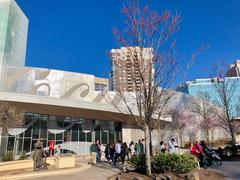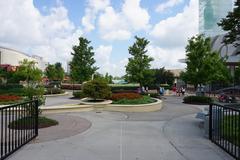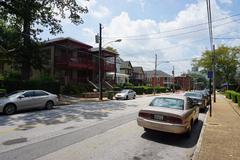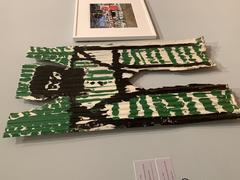Visiting Fernbank Forest: Hours, Tickets, and Historical Sites in Atlanta
Date: 31/07/2024
Introduction
Nestled in the bustling city of Atlanta, Georgia, Fernbank Forest offers a unique blend of natural beauty, historical richness, and educational opportunities. This 65-acre old-growth urban forest is part of the Fernbank Museum of Natural History and serves as a vital ecological and cultural landmark. Established in the late 1800s by visionary naturalist Emily Harrison, Fernbank Forest was preserved to safeguard Atlanta’s rapidly disappearing woodlands (Fernbank Museum). Over the decades, the forest has grown to become a significant conservation and educational resource, attracting nature enthusiasts, students, and tourists alike. Visitors can explore a variety of trails, engage in guided tours, and participate in numerous special events and educational programs that highlight the forest’s diverse flora and fauna (Snoflo). The Fernbank Museum of Natural History, adjacent to the forest, enhances the visitor experience with exhibits that delve into Georgia’s natural history, making Fernbank Forest a must-visit destination for anyone interested in nature, history, and conservation (Paige Minds the Gap).
Table of Contents
- History and Significance
- Visitor Information
- Navigating the Forest
- Special Programs and Events
- Safety and Accessibility
- Photography and Wildlife
- Nearby Amenities
- Additional Tips
- Conclusion
- FAQ
History and Significance of Fernbank Forest
The Founding of Fernbank Forest
Fernbank Forest’s origins date back to the late 1800s when a visionary naturalist named Emily Harrison recognized the irreplaceable value of the rapidly disappearing woodlands in Atlanta. Harrison’s foresight led to the preservation of 65 acres of forest, which she named ‘Fernbank’ after a creek bank covered with ferns, one of her favorite spots in the forest. This early conservation effort was ahead of its time, emphasizing the importance of preserving natural habitats amidst urban expansion (Fernbank Museum).
Establishment and Growth
In 1939, the Trustees of Fernbank purchased the forest to ensure its protection for future generations. This acquisition marked the beginning of Fernbank as a conservation organization, one of the oldest not-for-profit conservation entities in the United States. The forest’s preservation was further solidified with the opening of the Fernbank Museum of Natural History in 1992, which aimed to serve as ‘a school in the woods for nature studies’ (Fernbank Museum).
Ecological Significance
Fernbank Forest is the largest old-growth urban Piedmont forest in the United States, spanning 65 acres. This forest has remained largely untouched for thousands of years, making it a unique ecological treasure in the heart of Atlanta. The forest is home to a variety of rare plant and animal species, including the endangered Trillium reliquum. The forest’s biodiversity is a testament to its ecological importance, providing critical habitat for numerous species and serving as a living laboratory for scientific research (Snoflo).
Cultural and Educational Impact
Fernbank Forest has played a significant role in promoting environmental education and awareness. The Fernbank Museum of Natural History offers a variety of exhibits and programs related to the natural history of Georgia, allowing visitors to learn about the unique ecology of the forest. Guided tours led by knowledgeable naturalists provide an in-depth understanding of the forest’s flora and fauna, enhancing the educational experience for visitors of all ages (Fernbank Museum).
Conservation Efforts
The ongoing conservation work at Fernbank Forest is a testament to Emily Harrison’s vision. The forest’s preservation is a collaborative effort involving the Fernbank Museum, conservationists, and the local community. These efforts ensure that the forest remains a protected natural habitat, allowing future generations to experience its beauty and ecological significance. The forest’s conservation also includes maintaining its old-growth status, which involves protecting it from urban development and invasive species (Fernbank Museum).
Visitor Experience
Fernbank Forest offers a unique nature experience for visitors, with more than 2 miles of paths winding through the forest. These paths allow guests to craft their own experience, from a leisurely stroll to a brisk walk. The forest is accessible year-round, offering different experiences in each season. In spring, the forest is in bloom, and migratory birds pass through the area, making it an ideal time for birdwatching. In winter, the forest offers stunning views once the leaves have dropped, providing a different perspective of the landscape (Fernbank Museum).
Notable Features
Among the notable features of Fernbank Forest is the 50-foot-tall Champion White Oak tree, estimated to be over 300 years old. This ancient tree is a symbol of the forest’s longevity and resilience. Another point of interest is the 1940s-era log cabin, which was once used as a hunting lodge. These historical landmarks add to the forest’s charm and provide a glimpse into its past (Snoflo).
Community Engagement
Fernbank Forest actively engages with the local community through various events and programs. These include guided hikes, live animal encounters, and themed Discovery Days that explore the relationship between humans and forests. Events like Fernbank Forestry Day and Armored Animals Day offer hands-on activities and demonstrations, making learning about nature fun and interactive for visitors of all ages (Fernbank Museum).
Future Prospects
As Fernbank Forest continues to thrive, its future prospects remain promising. The ongoing commitment to conservation and education ensures that the forest will remain a vital part of Atlanta’s natural landscape. The Fernbank Museum’s efforts to expand its programs and exhibits will further enhance the visitor experience, making Fernbank Forest a must-visit destination for nature enthusiasts and families alike (Fernbank Museum).
Visitor Information
Operating Hours and Admission
Fernbank Forest is open daily from 10 AM to 5 PM. Tickets can be purchased online or at the Fernbank Museum, with prices ranging from $20 for adults to $18 for seniors, and $16 for children aged 3-12. Members enjoy free admission (Fernbank Museum).
Parking
Onsite parking at Fernbank is free, making it convenient for visitors to access the museum and forest without additional costs (Discover Atlanta).
What to Bring
Visitors are encouraged to wear comfortable walking shoes and bring water. The forest is stroller and wheelchair accessible. Nearby attractions include the Fernbank Museum of Natural History, the Michael C. Carlos Museum, and the Atlanta Botanical Garden. Public transportation options and parking facilities are available (Explore Georgia).
Navigating the Forest
Trail Maps and Signage
Trail maps are available at the entrance of the forest and the museum. The paths are well-marked with signs, making it easy to navigate through the different sections of the forest (Fernbank Museum).
Guided Tours
For a more in-depth experience, consider joining a guided tour led by museum educators. These tours provide valuable insights into the forest’s ecology, history, and conservation efforts (Wikipedia).
Self-Guided Tours
If you prefer exploring at your own pace, self-guided tours are also available. Informational plaques along the trails offer educational tidbits about the various plant and animal species you may encounter (Paige Minds the Gap).
Special Programs and Events
Fernbank After Dark
For adults looking for a unique experience, Fernbank After Dark offers science-themed events on select nights. These events often include access to the forest, allowing visitors to explore under the stars (The Atlanta 100).
Family Days and Educational Programs
Fernbank Museum hosts various family-friendly events and educational programs throughout the year. These include storytelling sessions, animal encounters, and themed family days, which often extend into the forest (Paige Minds the Gap).
Safety and Accessibility
Trail Safety
While the trails are generally safe, it’s important to stay on marked paths to avoid disturbing the natural habitat and to ensure your safety. Be mindful of uneven terrain and watch out for roots and rocks that could cause tripping (Wikipedia).
Accessibility
The main trails in Fernbank Forest are designed to be accessible to visitors of all ages and abilities. However, some areas may be challenging for those with mobility issues. It’s advisable to check with the museum staff for the best routes if accessibility is a concern (Fernbank Museum).
Photography and Wildlife
Photography
Fernbank Forest offers numerous opportunities for photography, from towering trees to vibrant wildflowers. Be sure to bring your camera or smartphone to capture the natural beauty. However, remember to respect the environment and avoid disturbing wildlife for the sake of a photo (Paige Minds the Gap).
Wildlife Watching
The forest is home to a variety of wildlife, including birds, squirrels, and occasionally deer. Early morning or late afternoon are the best times for wildlife watching. Bring binoculars for a closer look at the forest’s inhabitants (Wikipedia).
Nearby Amenities
Fernbank Café
Located within the museum, the Fernbank Café offers a selection of sandwiches, soups, pizzas, and kids’ meals. It’s open daily from 11 a.m. to 4 p.m., providing a convenient dining option during your visit (Paige Minds the Gap).
Museum Store
The museum store features over 3,000 unique and educational gifts for children and adults. It’s a great place to pick up souvenirs or educational materials related to your visit (Paige Minds the Gap).
Additional Tips
Timing Your Visit
To make the most of your visit, consider arriving early in the day. This allows you to explore the indoor exhibits first, then tackle the outdoor exhibits and the Georgia summer heat before coming back in to cool off while watching a movie on the Giant Screen (Paige Minds the Gap).
Discounts and Passes
Consider purchasing an Atlanta CityPASS for discounted admission to Fernbank Museum and other top Atlanta attractions. This can be a cost-effective way to explore multiple sites during your stay (CityPASS).
Conclusion
Fernbank Forest stands as a testament to the foresight of early conservation efforts in Atlanta and continues to be a thriving hub for ecological education and preservation. With its rich history, diverse ecosystems, and comprehensive visitor programs, the forest offers a unique opportunity to connect with nature within an urban environment. Whether you’re exploring the trails, participating in guided tours, or attending special events like Fernbank After Dark, there’s something for everyone at Fernbank Forest (Fernbank Museum). The ongoing conservation efforts ensure that this natural haven remains protected for future generations, allowing visitors to enjoy its beauty and learn about the importance of preserving our natural habitats. As you plan your visit, take advantage of the various amenities and nearby attractions to make the most of your time in Atlanta (Explore Georgia). With its commitment to education, conservation, and community engagement, Fernbank Forest is more than just a destination—it’s an experience that enriches the mind and soul.
FAQ
Q: What are the visiting hours for Fernbank Forest? A: Fernbank Forest is open daily from 10 AM to 5 PM.
Q: How much do tickets cost? A: Ticket prices range from $20 for adults, $18 for seniors, and $16 for children aged 3-12. Members enjoy free admission.
Q: Where can I purchase tickets? A: Tickets can be purchased online or at the Fernbank Museum.
Q: Is Fernbank Forest accessible for strollers and wheelchairs? A: Yes, the forest is accessible for strollers and wheelchairs.
Q: Are there guided tours available? A: Yes, guided tours led by knowledgeable naturalists are available.
References
- Fernbank Museum of Natural History. (n.d.). Our Story: History. https://fernbank.museum/visit/our-story/history/
- Snoflo. (n.d.). Fernbank Forest. https://snoflo.org/parks/georgia/fernbank-forest
- Paige Minds The Gap. (n.d.). A Guide to Visiting Fernbank Museum of Natural History in Atlanta. https://paigemindsthegap.com/a-guide-to-visiting-fernbank-museum-of-natural-history-in-atlanta
- Explore Georgia. (n.d.). Atlanta. https://www.exploregeorgia.org/city/atlanta











